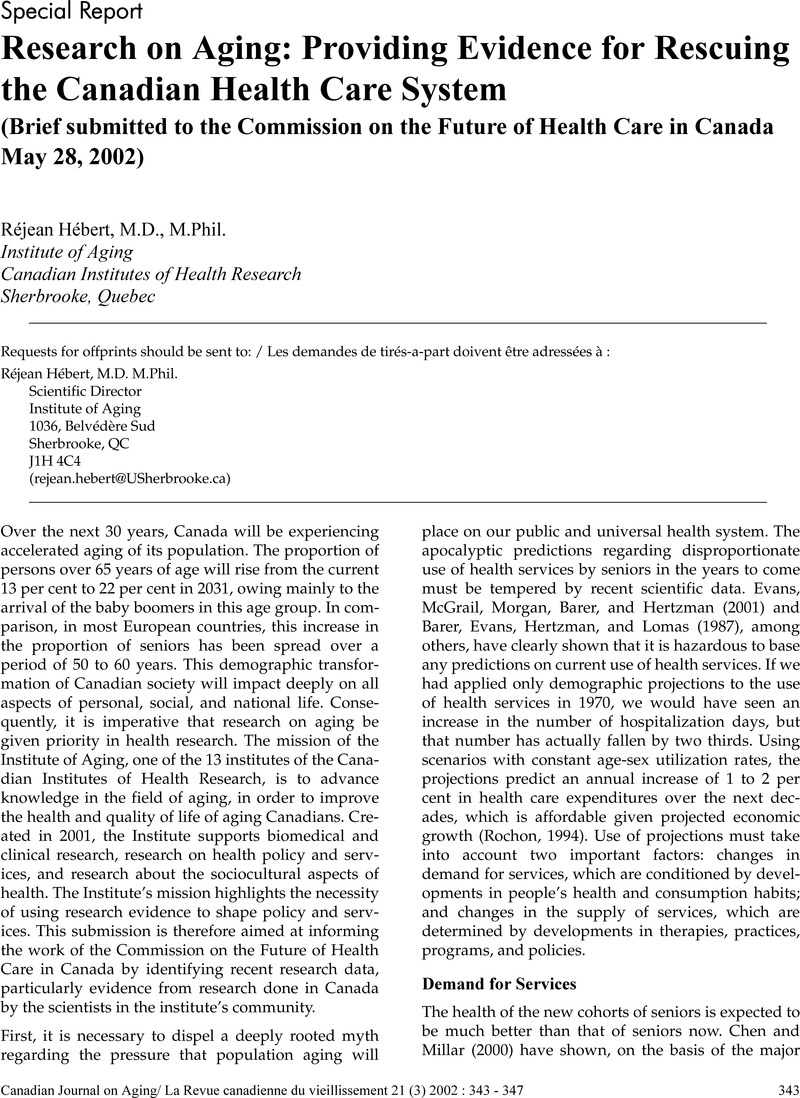Crossref Citations
This article has been cited by the following publications. This list is generated based on data provided by Crossref.
Hébert, Réjean
2003.
Yes to Home Care, but Don't Forget Older Canadians.
Canadian Journal on Aging / La Revue canadienne du vieillissement,
Vol. 22,
Issue. 1,
p.
9.
Shapiro, Evelyn
2003.
Le Rapport de la Commission Romanow et les Soins à Domicile.
Canadian Journal on Aging / La Revue canadienne du vieillissement,
Vol. 22,
Issue. 1,
p.
19.
Shapiro, Evelyn
2003.
The Romanow Commission Report and Home Care.
Canadian Journal on Aging / La Revue canadienne du vieillissement,
Vol. 22,
Issue. 1,
p.
13.
Willison, Kevin D.
Andrews, Gavin J.
and
Cockerham, William C.
2005.
Life chance characteristics of older users of Swedish massage.
Complementary Therapies in Clinical Practice,
Vol. 11,
Issue. 4,
p.
232.
Berta, Whitney
Laporte, Audrey
and
Kachan, Natasha
2010.
Unpacking the Relationship between Operational Efficiency and Quality of Care in Ontario Long-Term Care Homes.
Canadian Journal on Aging / La Revue canadienne du vieillissement,
Vol. 29,
Issue. 4,
p.
543.
Lacny, Sarah
Zarrabi, Mahmood
Martin‐Misener, Ruth
Donald, Faith
Sketris, Ingrid
Murphy, Andrea L.
DiCenso, Alba
and
Marshall, Deborah A.
2016.
Cost‐effectiveness of a nurse practitioner‐family physician model of care in a nursing home: controlled before and after study.
Journal of Advanced Nursing,
Vol. 72,
Issue. 9,
p.
2138.
Berta, Whitney
Laporte, Audrey
Perreira, Tyrone
Ginsburg, Liane
Dass, Adrian Rohit
Deber, Raisa
Baumann, Andrea
Cranley, Lisa
Bourgeault, Ivy
Lum, Janet
Gamble, Brenda
Pilkington, Kathryn
Haroun, Vinita
and
Neves, Paula
2018.
Relationships between work outcomes, work attitudes and work environments of health support workers in Ontario long-term care and home and community care settings.
Human Resources for Health,
Vol. 16,
Issue. 1,
Wilson, Donna M.
Shen, Ye
and
Low, Gail
2018.
Use of Hospitals by Older versus Younger Canadians: Myths and Misconceptions.
Canadian Journal on Aging / La Revue canadienne du vieillissement,
Vol. 37,
Issue. 3,
p.
309.
Berta, Whitney B.
Wagg, Adrian
Cranley, Lisa
Doupe, Malcolm B.
Ginsburg, Liane
Hoben, Matthias
MacEachern, Lauren
Chamberlain, Stephanie
Clement, Fiona
Easterbrook, Adam
Keefe, Janice M.
Knopp-Sihota, Jennifer
Rappon, Tim
Reid, Colin
Song, Yuting
and
Estabrooks, Carole A.
2019.
Sustainment, Sustainability, and Spread Study (SSaSSy): protocol for a study of factors that contribute to the sustainment, sustainability, and spread of practice changes introduced through an evidence-based quality-improvement intervention in Canadian nursing homes.
Implementation Science,
Vol. 14,
Issue. 1,
Wilson, Donna M.
Zhou, Yiling
Bolaji-Osagie, Sarah
Bryenton, Farrell M.
Dou, Qinqin
and
Low, Gail
2024.
Hospital utilization by older and younger patients in Canada: pre-pandemic findings.
Journal of Public Health Policy,
Vol. 45,
Issue. 4,
p.
771.



